![]()
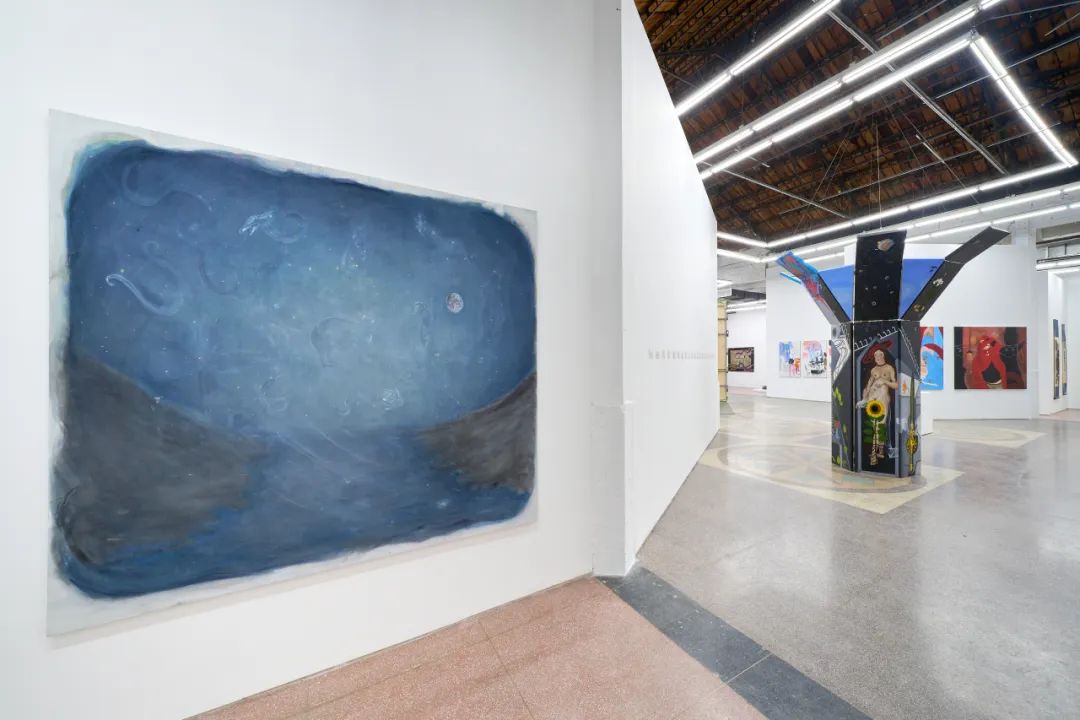
|
「米修米修收到信号了吗」展览现场 Horizons: Is there anybody out there? Installation view Part 1&2 Words by curator Robin Peckham |
Exhibition Period | 展览时间
2023.9.16 – 10.25
Exhibition Address | 展览地点
天线空间 AntennaSpace
上海市莫干山路 50 号 17 号楼 202 室
Room 202, Building 17, No.50 Moganshan Rd. Shanghai
01
天线的隐喻
Metaphor of the Antenna
| 展览以墨西哥城艺术家Frieda Toranzo Jaeger纪念碑式的绘画作品开场。《For new futures we need new beginnings》(2022)共有23块画面以铰链组装而成,既在接地处呈六棱柱状,又从上方垂下一块倒金字塔的华盖。这种“既A且B”的特质贯穿了Toranzo Jaeger的实践:她绘制的图像既富有未来感又带有宗教色彩,既超凡脱俗又切实可感。她形容,自己绘画的折叠结构参照了祭坛画一类的传统。这类视觉艺术形式多用在教堂建筑中,特别是欧洲拓殖时代最为显著;艺术家也将这些祭坛画类型本身的叙事策略调整为自己的叙事方式。在《For new futures we need new beginnings》下半部的画面中,主要是星际飞船的驾驶舱视野,并由各处的舷窗景观打断画面的整体性,如粉色汽车内饰、MacBook和其他类似的镜框装置,而高处的画面则向外张开,朝我们观众头上过顶延伸出去,将驾驶舱舷窗的星空景致坍缩成一个抽象空间,并作为背景呈现一系列刺绣而成的图标:一位天使,一棵开花的多肉植物,一个阴部形态的蔬菜。Toranzo Jaeger为自己定义了她的视界,这很美;在她的宇宙之旅中,没有特定目的地,但前方和身后的飞行路线通过当前位置紧密地连接在一起,在即便是最空旷的太空中,自我仍得以体现。 |
The exhibition opens with a monumental painting construction by the Mexico City-based artist Frieda Toranzo Jaeger. For new futures we need new beginnings (2022) is assembled out of 23 panels connected with hinges, simultaneously rooted on the ground in the shape of a hexagon and suspended from the ceiling with the volume of a pyramid. This quality of being “both-and” permeates Toranzo Jaeger’s work: her imagery is futuristic and religious, otherworldly and tangible. She relates the folding structures of her paintings to the altarpieces and other various formats through which visual art contributed to the architecture of the church, particularly just prior to the Age of Contact that launched Europe’s colonial project – a form of reverse appropriation, as she describes it, that embraces the performativity of the mobile altar object – and she adapts some of the narrative strategies inherent to these genres to her own storytelling. In For new futures we need new beginnings, the lower panels are dominated by the cockpit of an interstellar spaceship interrupted at various points with windows into the pink interior of a car, a MacBook, and other framing devices, while the upper panels – which lean outwards over us as viewers – explode the view of stars through the cockpit windows into an abstract space that becomes field for a series of embroidered icons: an angel, a flowering succulent, a vaginal vegetable. These are icons for a new era, vessels for belief. Toranzo Jaeger locates her own horizon, and I find this beautiful; on her cosmic road trip there is no destination, but the flightpath ahead and behind remain intimately connected via the present location, and the self is able to manifest even in the emptiest of spaces.
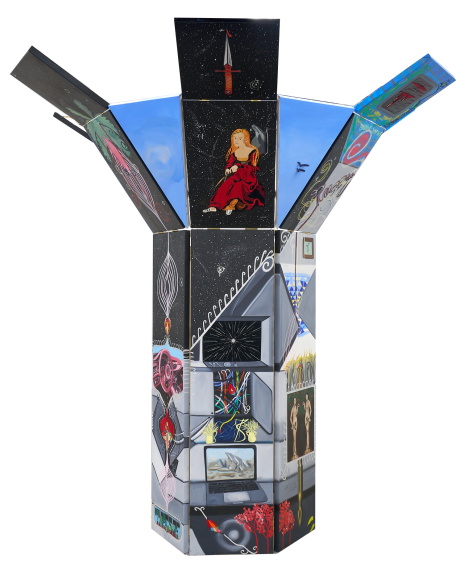
Frieda Toranzo Jaeger
弗里达·托兰佐·耶格
For new futures we need new beginnings
为了新的未来,我们需要新的开始, 2022
Oil and embroidery on canvas (23 parts)
布面油彩和刺绣 (23 块)
300 x 180 x 180 cm
| 我们一面将目光继续停驻在星空上,一面走向Tara Walters的《Moonlight Constellations》(2022);这幅画为我们提供了一个悬置在陆地和海洋之间,难以确定的视界。Walters绘画的装裱很别致,可以看到一层相对泛白的粗棉布环抱着画面,让它有如悬空漂浮一般,就像是内置一个传送门在上面,并且真有背光的光源。说到Walters在构图过程中的突破,我想是她将颜料与海水混合,让画面反过来阴干,从而让地心引力和随机性参与她的底稿制作过程;干燥后,硬质边框收缩绷紧,从而得到了一种有机的画面形式。她许多描绘有海的画作,也让故事和材质之间获得一种同一性——用海洋自身来绘制海洋,还有什么比这点更能引起共鸣呢?关于这些画作所传达的真实,仿如潮水般无孔不入。至于这幅画作,我们可以感到在最清晰、最稳定的星体(月亮)与最模糊却也最为耀眼的星体(大熊星座)之间生成了一种张力,前者就像微微浮在其上的一枚硬币,而后者则是无数以兽为名的繁星中的一枚,从天空与大海基质中升起,两者同属一个平面,犹如揽镜自照,轻易便穿越地平线。 |
We remain with our gaze fixed on the stars as we move toward Tara Walters’s Moonlight Constellations (2022), a painting that rather perfectly offers us an indeterminate horizon to ponder, not strictly land nor sea. Walters’s paintings come with a specific framing device of their own, as we find a healthy border of relatively white muslin wrapping around the picture plane such that it seems to float free of its support, like a portal carved into the object with a real luminosity behind it. This is one of the central effects of the compositional process that Walters has pioneered: she mixes her pigments with sea water, and leaves them to dry face down so that gravity and chance play a role in the early stages of her composition, resulting in a broadly organic form that shrinks from the hard corners of the stretchers. That so many of her paintings depict the ocean makes for a beautiful marriage of story and material – what could resonate more than an ocean painted of the ocean itself? – and there is a seeping liquidity to the truth of these pictures. In this particular painting, we find a tension between the clearest, most stable object (the moon) and the blurriest, most radiant object (a bear: Ursa Major), the former a coin floating a layer above and the latter the culmination of a rich bestiary of constellations that emerge from the substrate of the sky and the ocean beneath it, belonging to a plane that traverses the horizon as simply as a glance in the mirror.
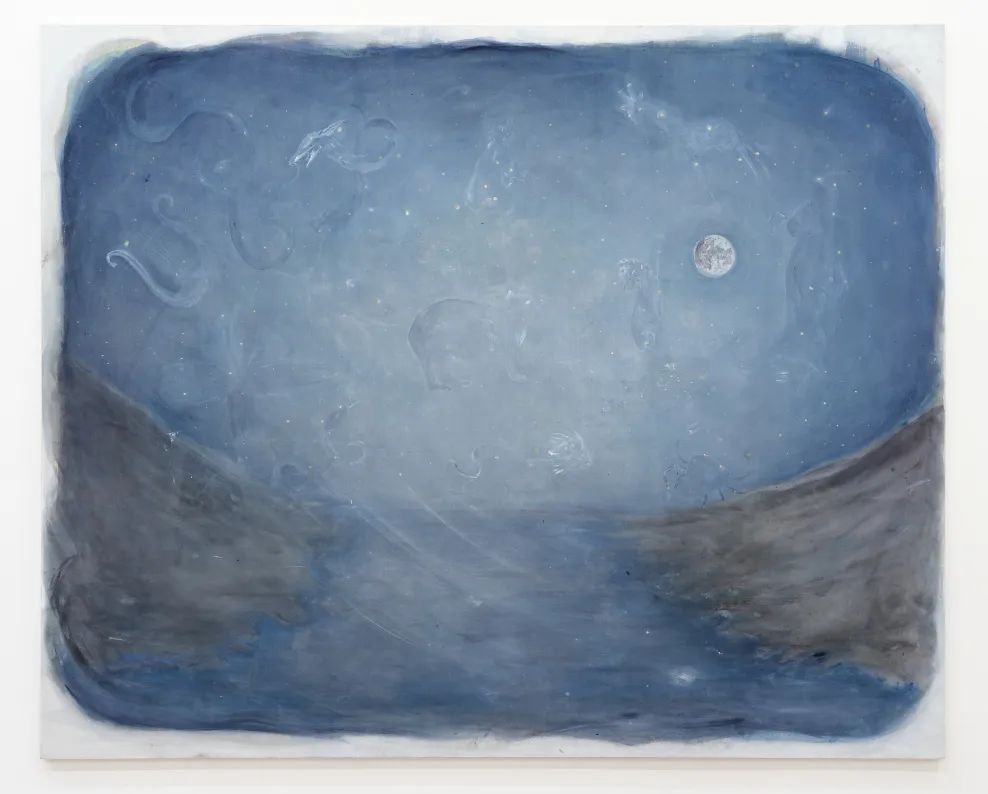
Tara Walters 塔拉·沃尔特斯
Moonlight Constellations 月色星宿 , 2022
Water based paint and the water of the Pacific Ocean on muslin
平纹细布上水性涂料和太平洋海水
203 x 244 cm
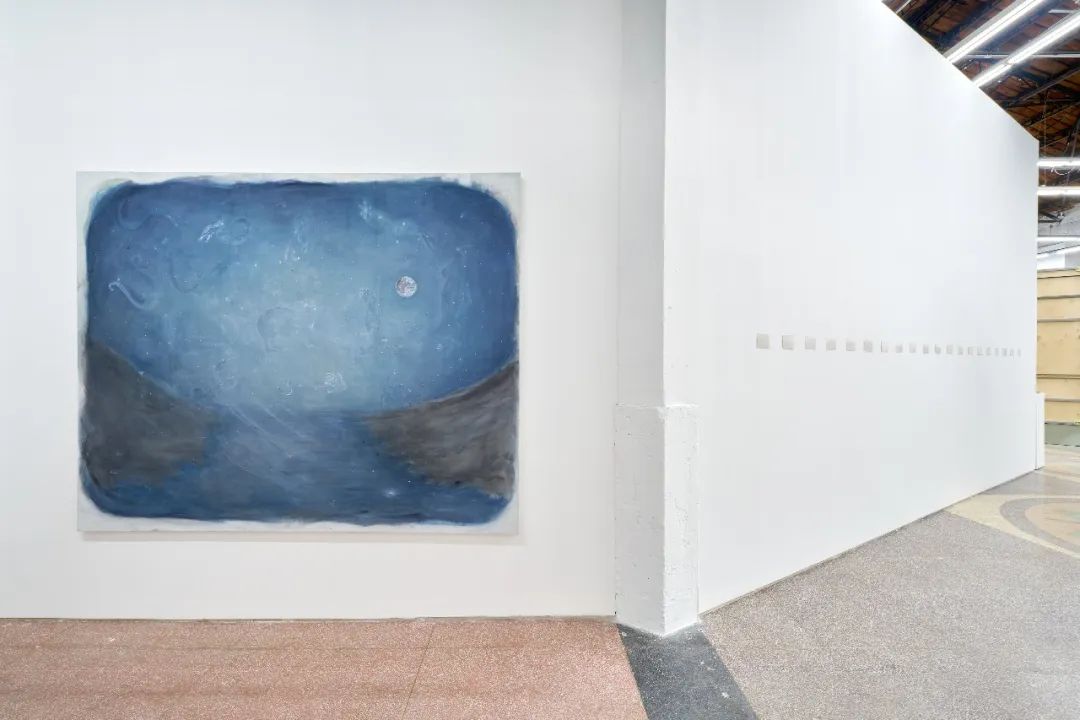
「米修米修收到信号了吗」展览现场
| 彭祖强的短片《青园》(2022)通过半透明亚克力板投影制造出幽灵般的重影,仿佛回应着影片的主题——游击地下电台。这样的主题既要藏匿自己的踪迹,同时又通过空中波段向所有人开放。作品的历史背景围绕在马共(最初由中国支持)对刚独立的马来西亚政府进行了长达20年的武装斗争。彭祖强以亲密的视角带领我们进入了流亡中国的马来亚革命之声的一段历史,展示了现场的实情(包括停用了的广播天线,现在被开发项目标为度假胜地预定地)并引导我们了解这一群体内部的人际关系(有一人因恋爱禁令而自杀)。这些虚构的档案材料与艺术家友人经营的民宿(名为“情人”)影像交织在一起,此处涉及另一种叠影:这家热带风情的民宿与即将落成的度假胜地。所有这些,都通过广播的声音空间联系在一起,乐曲和杂讯声,不时交织在两种类型的影像素材中。有的时候,我们的天线也会因为感官误导而错收信号。这件作品有种令人难以言表的气质,看着鬼影重重的影像记录下永远消失在历史中的电台,即便它本来只为特定的时间和地点而存在,今天却在人与人之间的关系空间中,获得了全新的意义。 |
A short film by Peng Zuqiang, The Cyan Garden (2022), is projected through a transparency, a ghostly double effect appropriate to its subject matter: a pirate radio station intended to be hidden from physical detection and yet simultaneously accessible to all over the airwaves. The historical context is the communist insurgency in Malaysia, during which the (initially China-backed) Malayan Communist Party continued a two-decade militant assault on the newly independent Malaysian government. Peng brings us into the intimate history of the Voice of the Malayan Revolution based in exile in China, showing us the physical realities of the site (including, yes, the radio’s broadcast antenna, now dormant and earmarked for development as a resort) and guiding us through the interpersonal politics of the team (one man committed suicide because romantic relationships were forbidden). This fictionalized archival material is spliced alongside other images of an Airbnb called “The Lover” operated by a friend of the artist, another doubling: this tropical-themed guesthouse and the coming resort. All of it is held together through the sonic space of radio, as songs and static weave in and out of both sources of dialogue. Misled by our senses, we sometimes pick up the wrong signals. There is something incredibly poignant about seeing these shadowy images documenting broadcasts lost forever to history, meant to exist only for a certain time and place and here today taking on an entirely new meaning in the space between people.
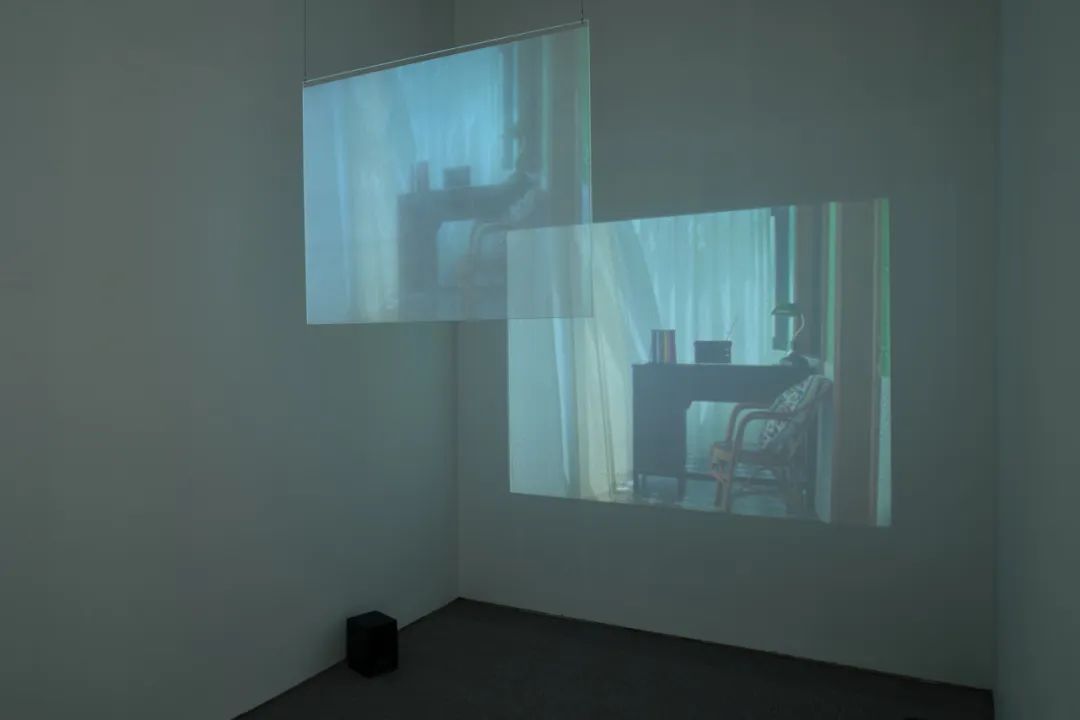
展览现场
Peng Zuqiang 彭祖强
The Cyan Garden 青园 , 2022
Single channel, color & BW, 16 mm transferred to HD video
单频 16 mm 胶片转录数字高清影像,彩色,黑白, 08'05''
02
分辨率、尺度、机器视觉
Resolution, Scale, Machine Vision
从这个仿如气仓的过渡性地带进入到展览的主要空间,我们在这边会遭遇一个艺术上的问题,同时也是我从接触艺术以来便一直关切的话题:人们的身体如何适应这些由机器的视野以及镜头主导的媒介所竞相创造的全新现实维度?而尽管艺术家们仍集中在为人类观众消费提供物件或情境,但他们确实也意识到他们作品的呈现方式越来越多技术中介的成分。包括记录给远方观众所使用的镜头选择,以及将作品辐射到各个地点的屏幕,再有可能,我们可以进一步想到从无线信号和保安系统衍生出来的宇宙,在向外发射信号过程中,无意间屏蔽了展览空间。在这个项目中,分辨率和尺度的结合,成为了这段对话的两个重要轴线;事物被降解成它们的组成单元——无论是分辨率、粒子或是技术协定——并在这些壁垒之间重新组装成新的画面。让我们回到星际观测的比喻:此刻,我们仿佛自己正在望远镜、显微镜和肉眼之间来回切换,才猛然意识到我们的观察常常无意间用了错误的视角。
Moving from this liminal airlock into the main body of the exhibition space, we encounter a question in art that has been central to my work since the very beginning of my engagement with art: how machine vision and lens-based media compete to create new dimensions of reality for the human body to absorb. While artists, by and large, continue to create objects and situations intended for consumption by are a human audience, they are also aware of the technologies that increasingly mediate the presentation of their work, from the shape of the lens that will document it for remote audiences to the screens that will invariably represent it at various points, and further on perhaps into an expanded universe of wireless signals and security systems that bind the space of the exhibition as they transmit it outward. In this project, resolution and scale come together as paired axes of conversation; things are broken down into their constituent parts – be they pixels or particles or protocols – and reassembled into new pictures between these walls. Returning to our metaphor of interstellar observation, we find ourselves shifting between the telescope, the microscope, and the naked eye, only to realize we’re often looking through them from the wrong end.
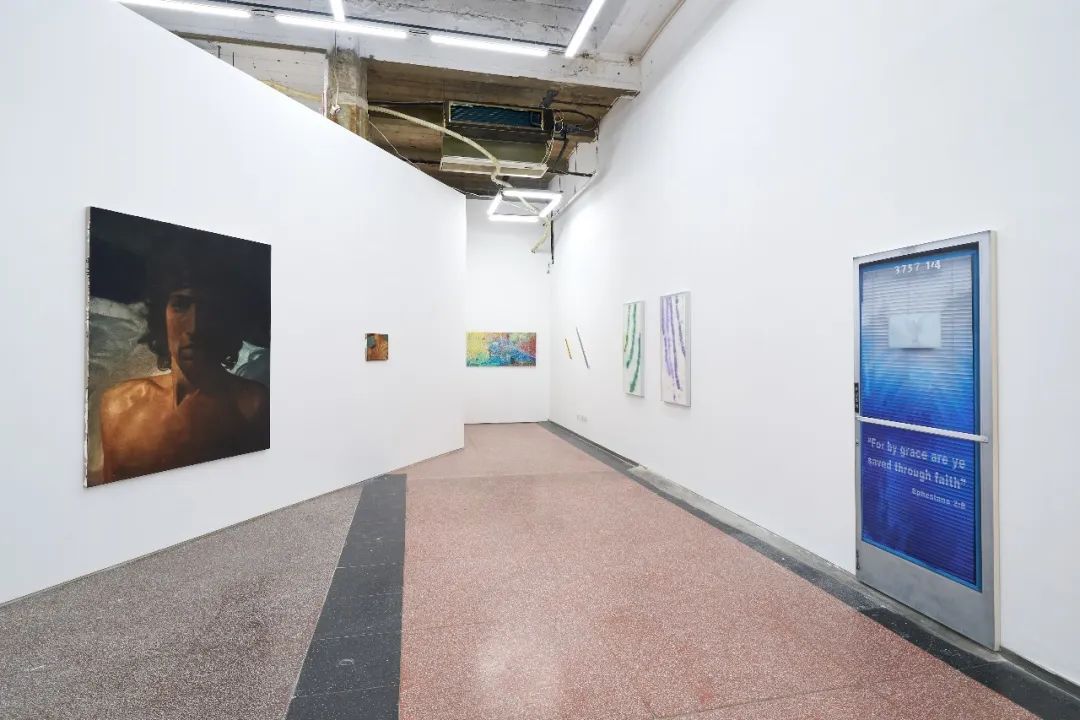
「米修米修收到信号了吗」展览现场
| Sayre Gomez在展厅空间中设置了一扇双重传送门。《Untitled 2》(2022)是一扇穿越时空之门,将作为观众的我们传送到距今至少一年之前在洛杉矶的某店铺,我们却不知道自己具体身在何处,为何在此,甚至自己是否仍然活着。这种空间上的诡谲之感正是Gomez的招牌手势,他以照相写实主义、稍微带点超现实、重度喷绘的构图而闻名,这些作品的灵感来源是南加州无序蔓延的神话,也反过来喂养这则神话。他的许多作品运用了镜头效果,将郊区风景模糊处理,或将焦段聚拢在很浅的景深内,创造出一种即刻满足又往往随之有短短的一股恶心不适的效果。作品中的这个入口是画出来的,材质是长玻璃板裱铝框,顶部则有街道编号,底部是圣经经文,在这之间则有一只褪了色的鸽子——或者是天使?Gomez为我们提供了购物中心式的救赎,但,或许这也是一则关于地平线另一端还有一个紧急出口的许诺。 |
Sayre Gomez installs a dual portal in the space. Untitled 2 (2022) is a door through space and time, connecting us as viewers to some storefront in Los Angeles at least a year ago but leaving us with no idea precisely where or why or if it even stills exists. This spatial uncanny has become Gomez’s trademark gesture, known for photorealist, slightly surreal, airbrush-heavy compositions that both draw from and feed the mythos of southern California sprawl. Many play with lens effects, blurring suburban landscapes or pulling particular focal ranges into tight focus, creating a sense of instantaneous gratification that often follows a brief wave of nausea. This particular door is a painting of a long sheet of glass in an aluminum frame, street number at the top, Bible verse at the bottom, faded dove – or is it an angel? – right in between. Gomez offers us strip mall salvation, surely, but perhaps also an emergency exit just across the horizon.
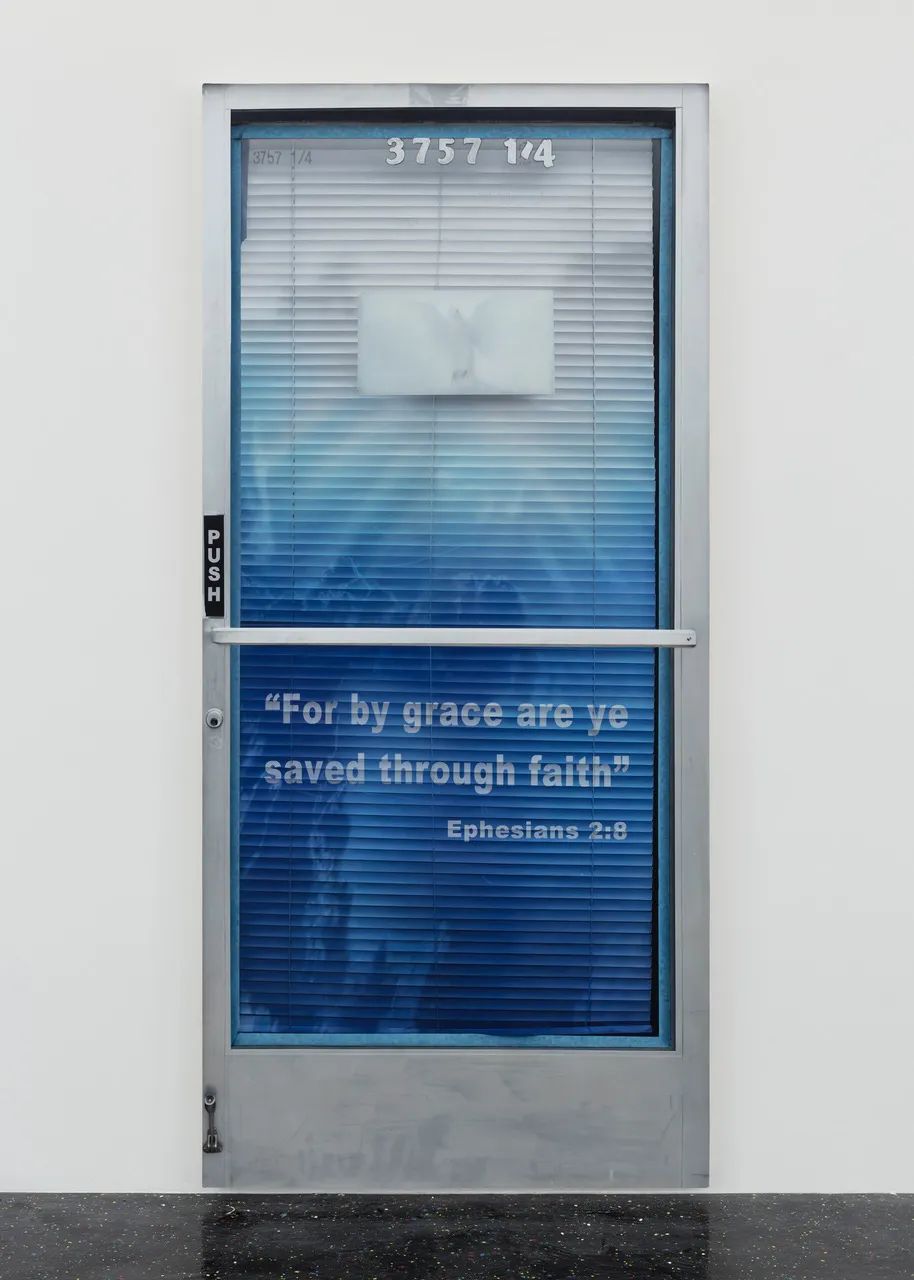
Sayre Gomez 塞尔·戈麦斯
Untitled-2 无题-2, 2022
Acrylic on canvas 布面丙烯
203.2 x 91.4 cm
| Helen Marten扮演了本次展览缝合各个概念的点,其作品《People, terms in barking (us)》(2018)将我们作为观众的现实拆解成物质层和参照层。为了让自己相信我们对这个太阳系中正在发生的事情有一定程度的理解,我们开始将最微小的细节放大,并在脑海中对它们进行分类,直到我们可以从中读到某种文法逻辑为止。一个直立式的屏幕,与一旁的工作和野餐台呈直角放置,而一旁尺度更小的集群则绕成了一个封闭轨道。蛇;鸡蛋;纱线;果酱;烛台;陶瓷;茶包;灯;字母:“家”;有一些属于室内空间的元素,另一些则是工业元素,其所代表的生产和再生产的范畴,仿佛蛇梯棋中的蛇与梯子,最终交缠在一起。垂直站立的画面上,花卉图案、符文和疲惫的脸庞在宽松的网格地带上交叉(请注意它左边的地平线)。在艺术家自己对这个项目的介绍中,Marten提请观众退一步来看待我们周围的动态:“这间房子是一种几何的工具,赋予抽象事物一个目的……它也是一个可以将混沌绘制出来的一个将视觉引爆的图表,并为可能的路径提供了方向……”。作品也涉及查尔斯·伊姆斯(Charles Eames)与雷·伊姆斯(Ray Eames)的电影《十的次方》(Powers of Ten):“地球上的一秒瞬间,竟能从一个人对草皮受压的细小感受,不可思议地转换到太阳系的广袤无际。”这样的工作需要投射、幻想和共情,将我们自己融入这个宇宙中,一起玩耍,从而找到一个位置。 |
Helen Marten’s People, terms in barking (us) (2018) fragments our reality as viewers into intense layers of materiality and reference. In order to trick ourselves into believing we have any degree of comprehension of what is going on in a solar system like this one, we zoom in on the tiniest of details, categorizing them in our minds until a kind of grammar emerges. A monumental vertical painting sits perpendicular to a workbench/ picnic bench, while smaller clusters sit in close orbit. Snakes; eggs; yarn; jam; candlesticks; ceramics; teabags; lamps; lettering: “HOME”; something of the domestic and something of the industrial, as if production and reproduction were mixed up together in a Rube Goldberg-designed game of Snakes & Ladders. On the vertical plane, floral motifs and runes intersect with tired faces across a loose grid (note the horizon at center left). In her own text on the project, Marten suggests zooming out to grasp the dynamics around us: “the house is the geometrical instrument which gives abstract things place for purpose … an exploded-view-diagram maps the chaos and lends organisation to the direction that feet might take…” Referring to the Charles and Ray Eames films Powers of Ten: “how quickly that single second down on the earth feeling the personal resistance of a grass stem bent out of place can be replaced with the impossible cosmic vastness of the solar system.” It takes the work of projection, fantasy, and empathy to insert ourselves into this cosmos, to play along and find a place.
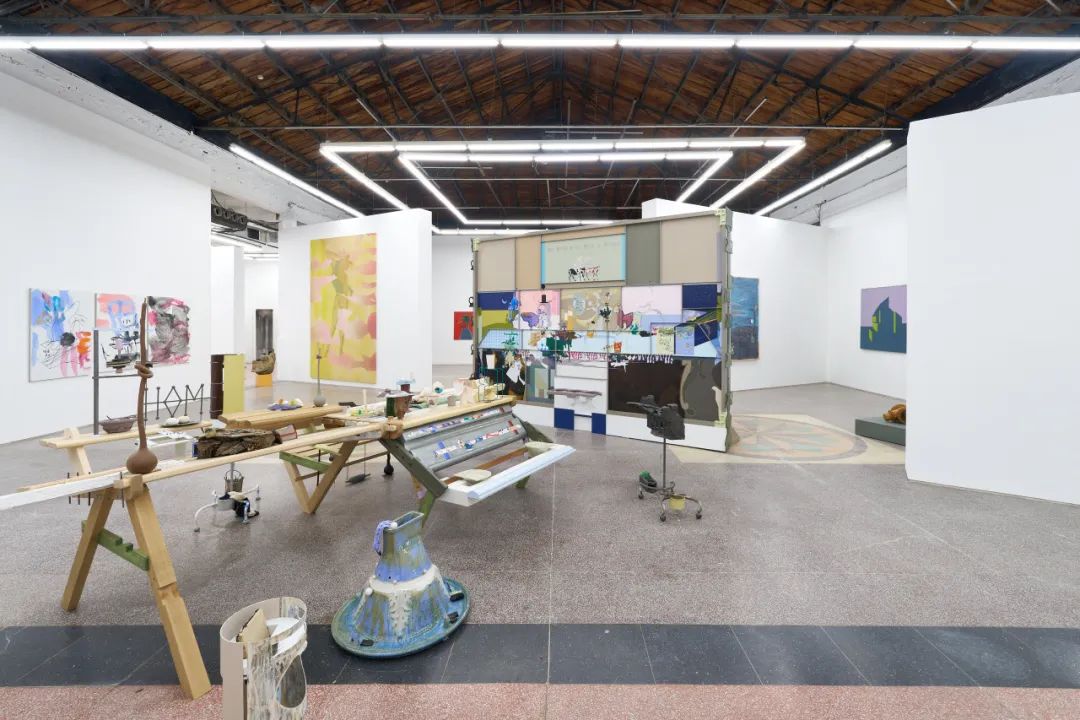
「米修米修收到信号了吗」展览现场
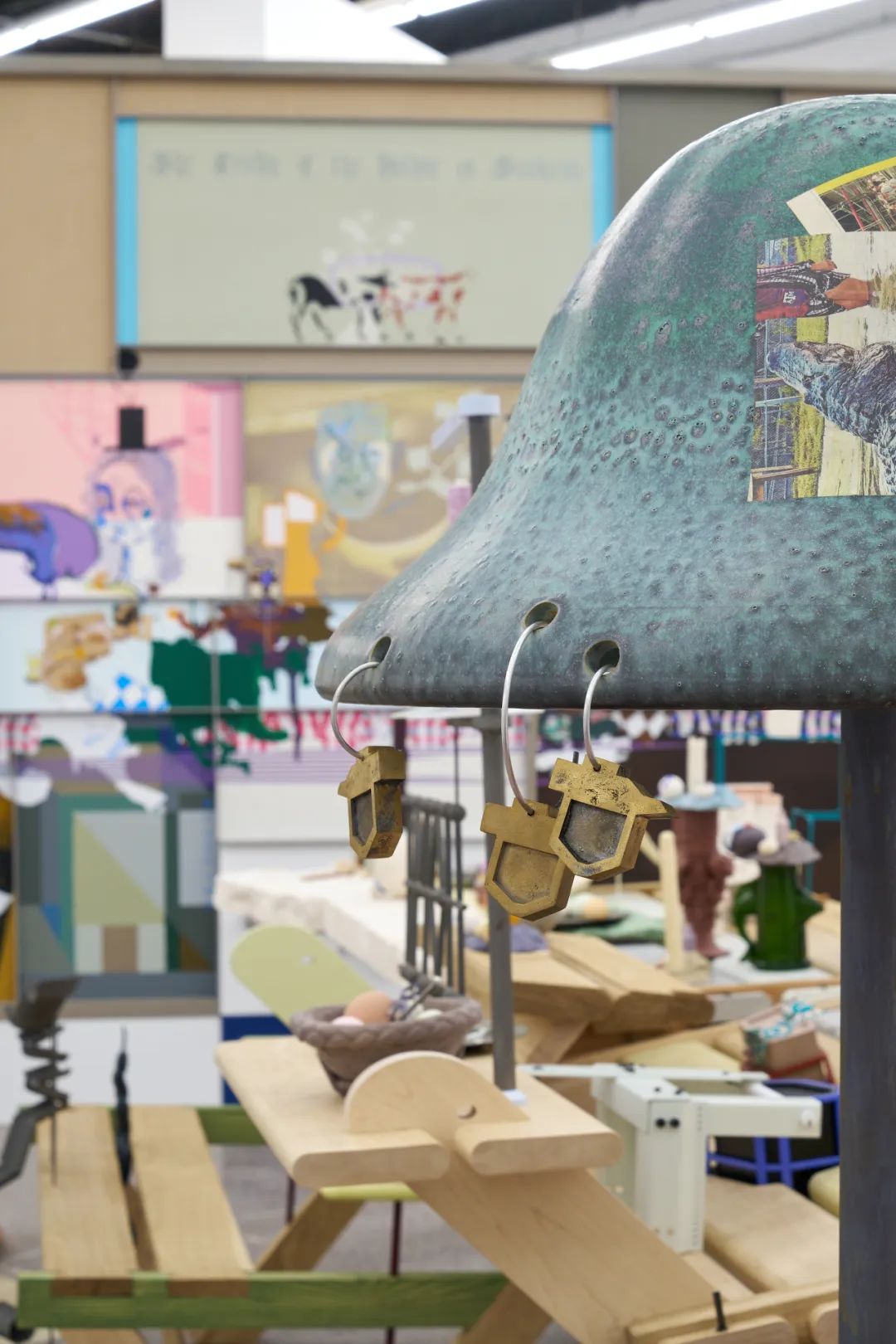
Helen Marten 海伦·马丁
People, terms in barking (us)(detail), 2018
Wood, steel, aluminium, cast resin, cast Jesmonite, embroidered fabric, glazed ceramic, cast bronze, milled modelboard, tree log, coins, rubber, cast aluminium, cast iron, chipboard, shellaced teabags, pressed flower, newspaper, string, Nylon paint on fabric, ash frame
木材,钢,铝,铸造树脂,铸造脆硫锑铅矿,刺绣织物,釉面陶瓷,铸造青铜,铣削模型 板,树干原木,硬币,橡胶,铸铝,铸铁, 刨花板,虫胶附着茶包,压花,报纸,绳子, 织物上的尼龙印物,白蜡木框
315 x 670 x 440 cm
| Carolyn Forrester在她的绘画作品《More Words from a Machine》(2023)中直接谈到了分辨率的概念。如同从草地到星空的尺度变化一样,这幅画中有非常多事情正在发生,差别在于,所有这些都被折叠在一起,多层次的参照被压缩成一个单一的物质基底,就像是入侵物种在旋转木马般转动的幻灯片投影上蔓延一样,插入到绘画史的片刻中。具体来说,Forrester是对可见性的条件做了推想,她经常借用类似《X档案》或《黑客帝国》(这件作品属于此类)等电影的偏执元素,然后通过三重的生成式现代主义手法进行筛选:在构图上,它属于苏菲·陶柏·阿尔普(Sophie Taeuber-Arp)和梅拉·奥本海姆(Meret Oppenheim)的抽象几何一脉;在风格上,它继承点彩画派或印象派的光学效果,从而与色彩学剥离开来,进入理论生产机器的范畴;在观念上,它算是毕卡比亚(Francis Picabia)一类,从旁取径探索绘画语法。通过这几个层次,观看(或不观看)的过程,成为了视觉的对象。 |
Carolyn Forrester speaks directly to the concept of resolution in her painting More Words from a Machine (2023). There seems to be just as much going on here, a transition of scale as far from the grass to the stars, but in this painting it is all collapsed together, manifold layers of reference condensed into a single material substrate that inserts itself into moments from the history of painting like an invasive species proliferating across the carousel of the slide projector. Specifically, Forrester speculates on the conditions of visibility, often drawing on the paranoid logic of moving images like The X-Files or (as here) The Matrix, which are then filtered through threefold processes of generative modernism: compositionally, it is the abstract geometric fields of Sophie Taeuber-Arp and Meret Oppenheim; stylistically; it is the optics of pointillism or impressionism, divorced from color theory and instead engaged to the hypothetical machine; and conceptually it is Picabia, the grammar of painting beside itself. Through these layers, the process of seeing (or not seeing) becomes the object of vision.

Carolyn Forrester 卡洛琳·弗雷斯特
More Words from a Machine 来自机器的万语千言, 2023
Oil on linen 亚麻布面油画
68 x 140 cm
| Josh Kline的作品“Supplements”系列(均创作于2022年)将智能手机粉碎(其中一件作品使用了两部iPhone 6,另一件作品则装有六部iPhone SE),并包装在明胶胶囊中。Kline的核心关注点之一是身体与消费技术之间的关系,尤其是它们如何相互引导:他的三维扫描和三维打印的人手或头部正是身体技术化的体现,另外,还有他的那件冰箱作品,里面装满了成分包含HDMI线和瑜伽垫之类的果汁。这种将日常生活材料不断分解和重组的手法,无疑是一个双向的过程——既认识到它们的不稳定性,又认识到它们的普遍性。但尽管我们早已习惯了这样的图像状况——低分辨率JPG图像的坏轨、模糊,以及这些图像所派生出来的绘画——但要在进一步,更高层次的状态中见识到这些图像,确实令人感到特别不安,仿佛它是我们自己的身体的一部分,被咀嚼后再吐出,成了这些奇怪的小黑丸。 |
Josh Kline’s “Supplements” (both 2022) consist of pulverized smartphones (one containing two iPhone 6s, and the other six iPhone SEs) packed into gel capsules. One of Kline’s core concerns has been the relationship between the body and consumer technologies, particularly how one interpellates the other: think of his 3D-scanned and 3D-printed human hands or heads as the technification of the body, but also his refrigerator full of smoothies with ingredients like and HDMI cables and yoga mats. Invariably a two-way process, this constant breaking down and rebuilding of the materials of everyday life recognizes both their instability and their near ubiquity. But while we’re used to seeing this happen with images – the glitching and blurring of lo-res JPGs and the paintings they spawn – there is something particularly discomfiting to experiencing it on the next highest level of order, as if it could be a part of our own body chewed up and spat out into these odd little black pills.

Josh Kline 乔什·克莱恩
Prototype for Supplements (iPhone 6, black)
补剂原型 (iPhone 6,黑色 ), 2022
Two black iPhone 6 phones, gelatin capsules, dyed PETG plastic, acrylic 2 个黑色 iPhone 6 手机,明胶胶囊,染色PETG 塑料,丙烯
3.5 x 48.6 x 1.9 cm
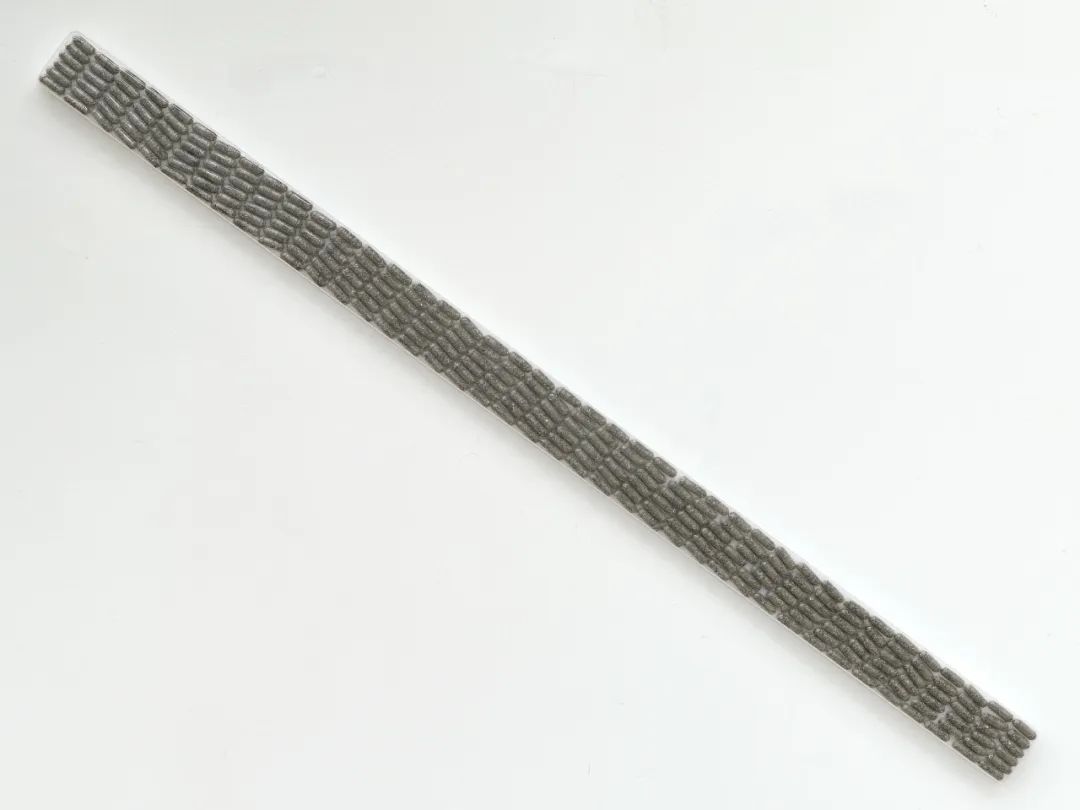
Josh Kline 乔什·克莱恩
Supplements (iPhone SE 2nd generation,black)
补剂 ( 第二代 iPhone SE,黑色 ), 2022
Six black iPhone SE 2nd generation phones, gelatin capsules, PETG, plastic, acrylic 6 个黑色第二代 iPhone SE 手机,明胶胶囊,PETG 塑料,丙烯
5.1 x 98.1 x 1.9 cm
| 在这两条清晰而坚实作品的一旁,一组线条将人们的注意力从视线高度引导到低处,从而让我们看到这两件纸上彩墨绘画,而它们再轻轻地将我们的视线引导回一个高度,仿佛在暖天里追随着一个在轻飞中微微沉降的一根风筝线。周思维的作品《5G风03》和《5G风04》(均为2022年创作)运用墨水晕开的效果绘制而成,仿佛作品名称中的5G符号变成了一枚印章,上下颠倒地盖在纸面上。周思维的绘画以其严谨的构图逻辑,对绘画传统和对绘画盲点的调用,从而对当代艺术横行的一种生产模式(使用“互联网下载下来的现成图像”)的颠覆所为人所知,并进一步改造互联网的图像状态,将弱图像拔高。“5G风”系列也暗示了随着最新无线技术推出而大行其道的偏执狂和阴谋论(如西方发生5G基站纵火案,认为它会传播Covid-19,而在中国,则有口号将5G夸饰为高效生产的代表),并赋予了它们一定的可信度,因为我们越来越快速、方便和无所不在的互联网接入,确实为我们今天的生活注入了新的焦虑感。它是一种冷漠疏远的美,温柔包裹着此种不可见力量带来的无可拒绝的特质。 |
Alongside these two sharp and solid ley lines drawing the eye from its own level down to the floor of the space sit two paintings that gently pull the gaze back upward again, as if following the string of a gently dipping and diving kite on a balmy day. By Zhou Siwei, 5G Wind 03 and 04 (both 2022) are produced with a diffuse ink, almost as if the titular code, “5G,” had been rubber stamped up and down these sheets of paper. Zhou is known for paintings that transform that infamous crutch of contemporary art (“images found on the internet”) through rigorously considered logics of composition, calling on the traditions and blindspots of painting to reform the internet – turning a poor image into a sacred one. With the “5G Wind” series he alludes to the paranoia and conspiracy logic that accompanied the rollout of this latest wireless technology (remember, in the west, the arson attacks on 5G towers accused of spreading Covid-19, or, in China, the sloganeering around 5G as a marker of productive capacity?), and lends them a degree of credence, because our increasingly fast, convenient, and pervasive internet access has indeed injected a new layer of anxiety into the way we live today. It is a cold and distant beauty that wraps itself gently around the irresistible effects of invisible forces like these.
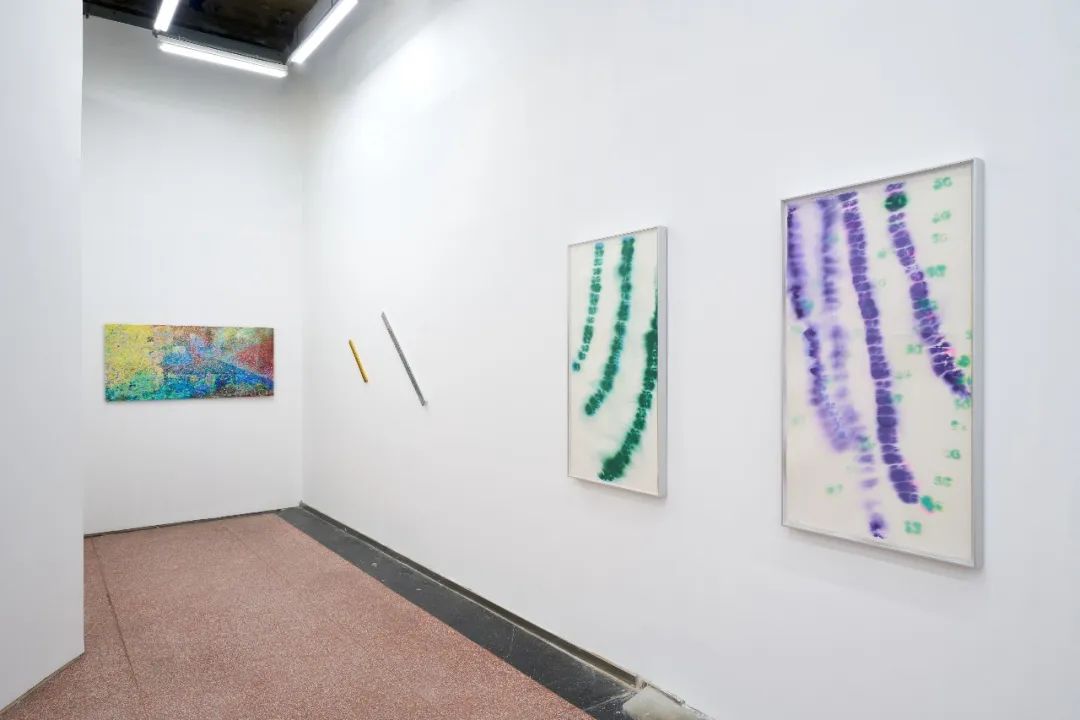
「米修米修收到信号了吗」展览现场
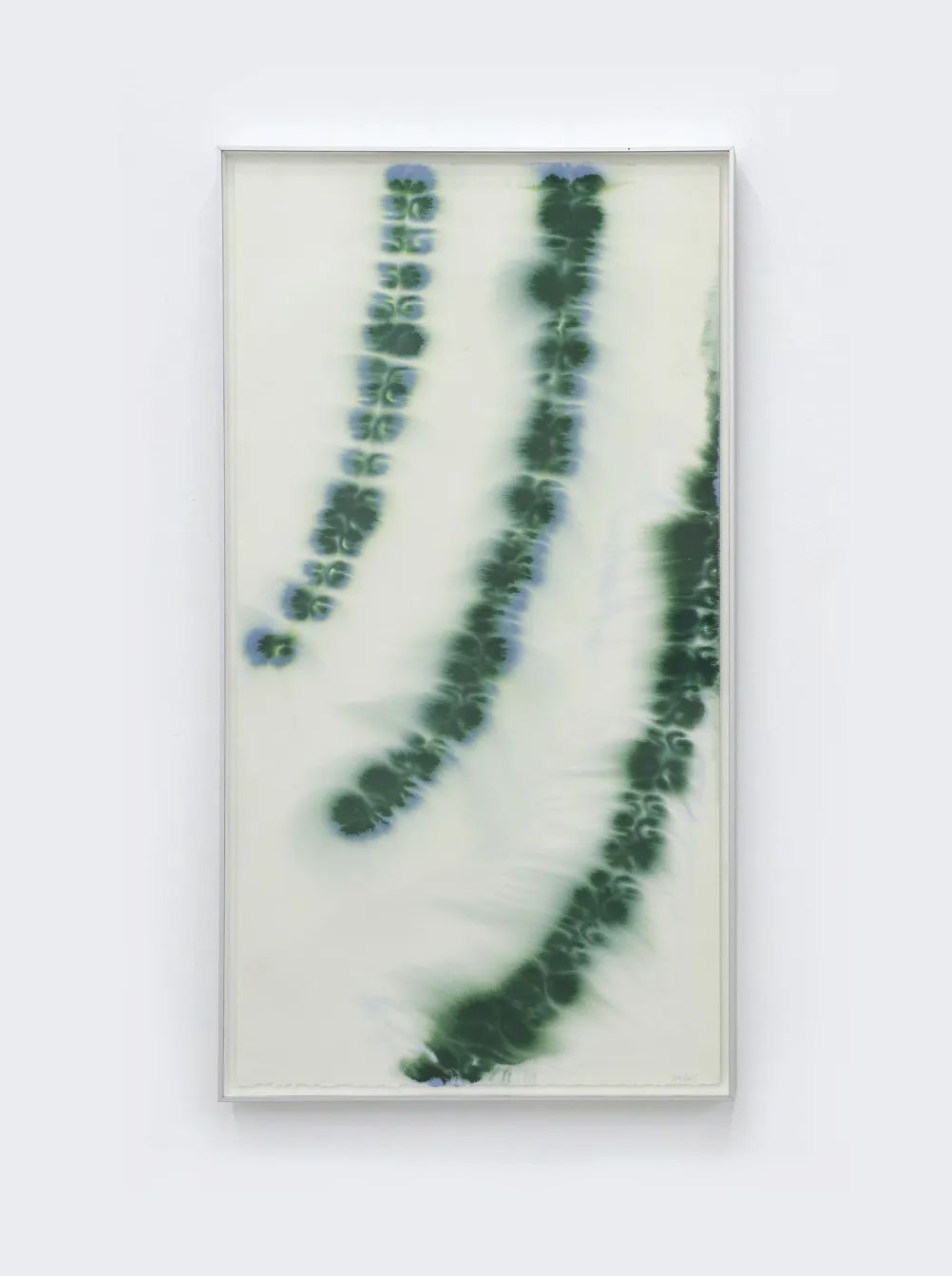
Zhou Siwei 周思维
5G Wind 03 5G 风 03, 2022
Color ink on paper 纸上彩墨
115 x 64 cm

Zhou Siwei 周思维
5G Wind 04 5G 风 04, 2022
Color ink on paper 纸上彩墨
115 x 64 cm
| 作为这一章节最引人入胜的主结构,Joseph Yaeger呈现了两幅画作,它们既非常带有绘画性,又非常具有电影感。他的创作素材来自电影,并且对描绘镜头的效果、画面比例等影像媒介的踪迹有着特别的热情,但与此同时,这些叙事之外的事物,却被绘制得仿佛就是绘画构图的一部分,而不是源于电影画面;这种区别虽然微妙,又不可忽视,绘画也因此就在这两个层面之间不断地摆荡——而两者之间实际上根本没有距离。而且,Yaeger用的是水彩,他用难以言喻的熟练技巧操纵这些视觉效果,以唤起闪烁、反射、朦胧、半透明的一个世界。在《We swallow dead things》和《Primary mechanism》(均创作于2023年)中,我们可以注意到朦胧的脸庞和映射中的锁骨,这些画面仿如具身的图表,象征着虚无的实在性,让我们怀疑宗教体验的存在。 |
Joseph Yaeger, appearing here with two paintings, is a fascinating capstone for this chapter in that the works are simultaneously supremely painterly and supremely cinematic. In his source material he draws from films, and has a particular passion for including lens artifacts and aspect ratios and other markers of this medium, but at the same time these extra-diegetic moments are produced as if they were part and parcel of the composition of the painting rather than as a component of the filmic image; the difference is subtle but unmistakable, resulting in a constant shuddering between the these two layers of the painting – and between which there is really no distance at all. And Yaeger does it in watercolor, working these images with unthinkably deft skill in order to call on the glinting reflections and blurred transparencies that make up his universe. In We Swallow Dead Things and Primary Mechanism (both 2023) we note shadowy faces and reflective clavicles, diagrams of embodiment signaling the somethingness of nothing. We suspect religious experience.
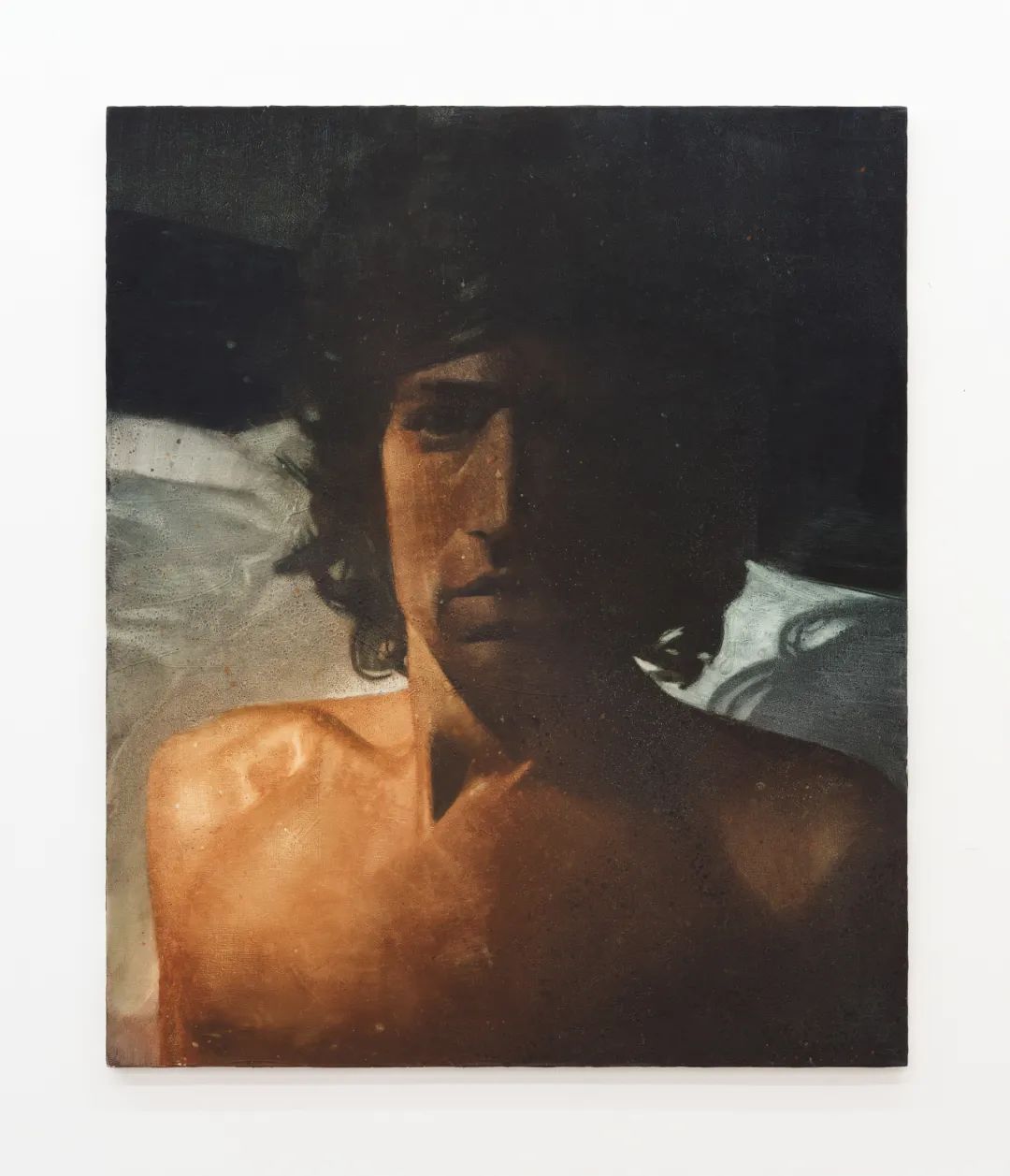
Joseph Yaeger 约瑟夫·耶格尔
Primary mechanism 主要机制, 2023
Watercolour on gessoed linen 石膏亚麻布面水彩
180 x 150 x 4 cm

Joseph Yaeger 约瑟夫·耶格尔
We swallow dead things 我们吞咽逝去之物, 2023
Watercolour on gessoed linen 石膏亚麻布面水彩
31 x 41 x 2 cm

「米修米修收到信号了吗」展览现场
翻译:陈玺安
校编:成希月
图片致谢艺术家及天线空间
摄影:Cra
©文章版权归属原创作者,如有侵权请后台联系删除
